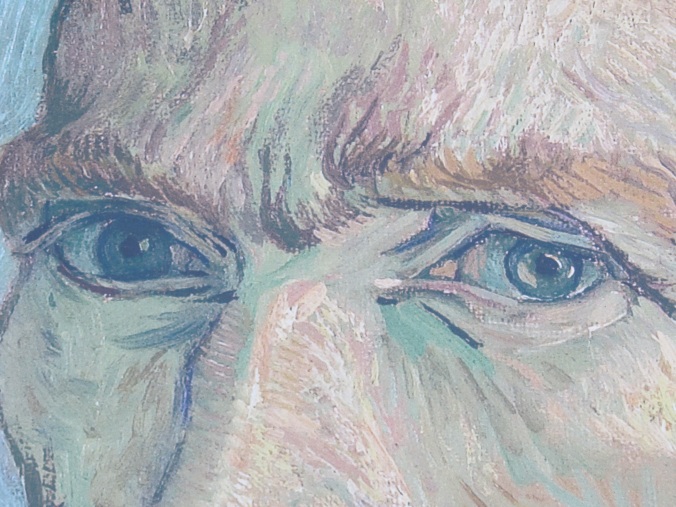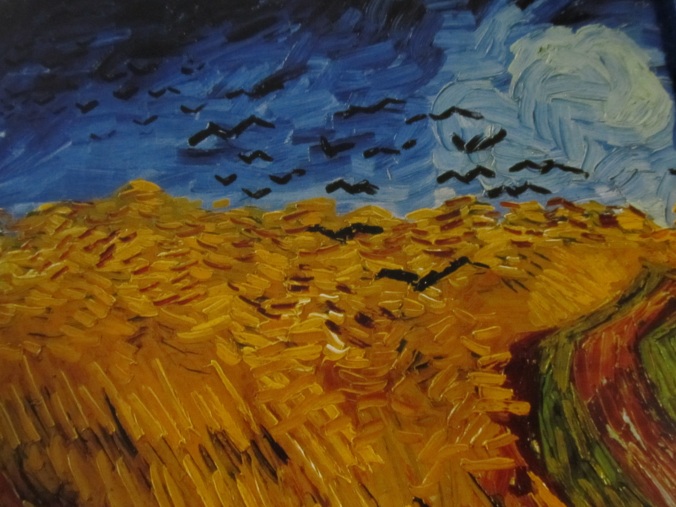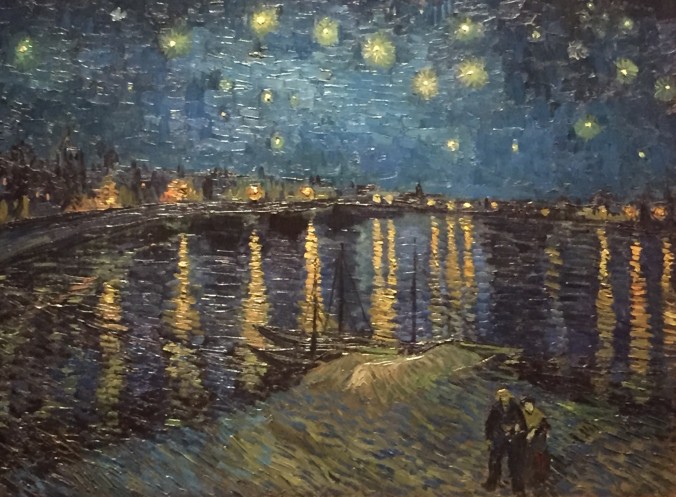When I first read about Loving Vincent, I was afraid that it would not come to Durham, NC. My fears were confirmed when I started seeing lists of cities where it would be playing on the film’s website and Facebook page. No Durham. The closest city listed was Fayetteville. Arles Lucy and I were ready to plan a road trip. Then, about a month ago, I saw that it would indeed come to our lovely downtown Carolina Theatre. I have now seen the movie twice, once with the Ex-Ex and once with my crew of girlfriends who have been to France with me. It is playing in Durham for an extra week so I may see it a third time. It IS that good, mes amis. If you have read my previous posts about Vincent (April 2014, May 2010, May 2010, November 2011) then you already know that I love him very much. Maybe a bit obsessively.
A team of 125 artists spent 6 years bringing Vincent’s paintings to life in 65,000 frames. The film is completely animated, with the scenes based on his paintings in color and the flashbacks to scenes of his life in black and white. The story comes to life as Armand Roulin, son of Postman Joseph Roulin of Arles, travels from Arles to Paris to give a letter to Theo, Vincent’s brother, a year after Vincent’s death. The letter had been found when Vincent’s landlord in Arles was cleaning out Vincent’s rooms in the Yellow House. However, upon finding Père Tanguy, Armand discovers that Theo died only six months after his brother. By this time, Armand wants to learn more about the last six weeks of Vincent’s life.
Vincent was a prolific letter writer. According to Mark Roskill in The Letters of Vincent Van Gogh, 670 of the letters Vincent wrote to Theo have survived to present day. The letters were gathered, transcribed and edited by Theo’s widow, Vincent’s sister-in-law, so that they could be published. The first batch of them was published only three years after Vincent’s death, in 1893. Johanna “Jo” van Gogh-Bonger spent years bringing the letters to light and was also instrumental in Vincent’s rise to fame as an artist. She inherited around 200 of his paintings upon the death of Theo and was seemingly relentless in her push to have Vincent’s talent recognized. Merci, madame.
The Van Gogh Museum in Amsterdam has put together a touching tribute to Vincent and Theo. The museum’s website is very well done. Someday, I hope to visit it in person. In Noord Brabants Museum in Den Bosch (an hour from Amsterdam), there is an exhibit about Loving Vincent that will run until January 28, 2018. Paintings from the movie are on display. I believe that they will then be sold.
Without giving too much away in case you haven’t seen the film yet, let’s just say that the final scene with Roulin and his son is my favorite. Vincent was shot on July 27, my birthday. One scene in the movie revealed that July 27, 1890 was a Sunday. July 27, 1958 was also a Sunday. Perhaps my love for Vincent is fate.
.png?1503930162)
CBS This Morning recently paid tribute to the film.
This clip from Dr. Who pays hommage to Vincent and allows him to hear praise for his work while standing in the Musée d’Orsay in Paris.
It is written that Vincent did not eat well or very much. He gave away most of what he had during his stint as a missionary. One of his early paintings, The Potato Eaters, 1885, is dark and somber. He often forgot to eat, I imagine, as he painted for hours on end. According to Biography.com:
Vincent van Gogh completed more than 2,100 works, consisting of 860 oil paintings and more than 1,300 watercolors, drawings and sketches. Several of his paintings now rank among the most expensive in the world; “Irises” sold for a record $53.9 million, and his “Portrait of Dr. Gachet” sold for $82.5 million.
Over the course of 10 years, van Gogh created more than 43 self-portraits as both paintings and drawings. “I am looking for a deeper likeness than that obtained by a photographer,” he wrote to his sister. “People say, and I am willing to believe it, that it is hard to know yourself. But it is not easy to paint yourself, either. The portraits painted by Rembrandt are more than a view of nature, they are more like a revelation,” he later wrote to his brother. The works are now displayed in museums around the world, including in Washington, D.C., Paris, New York and Amsterdam.

Some believe that Wheatfield with Crows, July 1890, Van Gogh Museum, Amsterdam, was Vincent’s last painting. I’ve walked through that field on the way to Vincent’s grave in Auvers-sur-Oise.

No story of mine about Vincent would be complete with this one, Starry Night over the Rhône, painted in Arles, September 1888, Musée d’Orsay, Paris.

What would Vincent eat? Here is a recipe I hope that he would have liked. Potato soup was a staple in the Bell-Gillespie household when I was growing up. There is nothing fancy about it, but it is delicious.
Leek and Potato Soup
Adapted from Dorie Greenspan’s Around My French Table
2 tablespoons unsalted butter
1 large onion, chopped (or 1-2 more leeks, if you prefer)
2 garlic cloves, split, germ removed and thinly sliced
(I also add 2 stalks of celery, chopped)
Salt and freshly ground white pepper (black pepper is fine)
3 leeks, white and light green parts only, split lengthwise, washed, and thinly sliced
2 large Idaho (russet) potatoes (I doubled this- Dorie calls for only one potato), peeled and cubed
6 thyme sprigs
2 sage leaves
4 cups chicken broth (or water but the broth gives it a richer taste)
3 cups whole milk
Optional toppings:
Minced parsley, sage, tarragon or marjoram, or a combination
Snipped fresh chives
Grated Parmesan, Gruyère or cheddar cheese
Croutons
Crispy bacon, crumbled
Corn kernels
Truffle oil
Melt the butter in a Dutch oven or soup pot over low heat. Add the onion and garlic and stir until they are coated with butter, season with salt and pepper, cover and cook for about 10 minutes, until the onion is soft but not colored.
Add the remaining ingredients, along with a little more salt, increase the heat, and bring to a boil. As soon as the soup bubbles, turn the heat to low, mostly cover the pot, and simmer gently for 30-40 minutes, or until the vegetables are soft. Taste the soup and season generously with salt and pepper.
You can ladle the soup into warmed bowls and serve as is, mash the vegetables lightly with the back of a spoon, or puree the soup through a food mill or with a blender (regular or immersion), or a food processor. (I leave mine with the potatoes in chunks.) If desired, garnish with the toppings of your choice.
You could also chill it and turn it into Vichyssoise, a fancy name for cold potato soup, which was invented in 1917 by French chef Louis Diat who ran the kitchens at the Ritz-Carlton Hotel in New York City, according to Dorie.
Bon appétit and thank you, BreakThru Films, Dorota Kobiela, Hugh Welchman and all the artists who re-created Vincent’s paintings. Thank you as well to all of my friends and students who have been to Paris and Arles with me and who have paid tribute to Vincent with me. In Vincent’s words:
Love many things, for therein lies the true strength, and whosoever loves much performs much, and can accomplish much, and what is done in love is done well.
Je t’aime, Vincent.
No comments:
Post a Comment